► McLaren 720S vs Honda NSX
► Supercar scrap in and about Tokyo
► Two unlikely rivals lock horns
Unrelenting rain has poured from murky November skies for four days now, flooding Tokyo’s streets, shrouding its skyscrapers in fog and making silent ghosts of the ships on the slate grey waters of the bay.
But last night the clouds cleared off. Now this most three-dimensional of cityscapes is alive with colour and contrast, and the bay dazzles like crushed ice.
From the best seat in the house – the cockpit of a glittering orange McLaren 720S – the Japanese capital finally looks good; looks the way it should. In the gloom that prevailed it sprawled like a game of Tetris gone bad, its artless grey building blocks crashed together in permanent disorder. Now it’s spectacular: teeming with people (nine million souls and counting) and possibility, vital with energy and vast. And everywhere there’s movement: shoals of traffic trundling across triple-deck overpasses, fast-moving scooters wheeling into wickedly sinuous tunnels and hard-working bridges that groan under the weight of endless freight.
Running hundreds of feet above the bay, the Rainbow suspension bridge gives unimpeded views of the spectacle. So too does the McLaren 720S, its jet-like bubble screen and glazed rear teardrop creating such an exhilarating sense of freedom that you almost feel vulnerable, like you’re driving an open Can-Am racer – at least until you remember the near-impregnable carbonfibre tub surrounding you.
Browse McLarens for sale in our classifieds
Moving stealthily with the morning commuter traffic the 720S feels special, its towering performance hidden away behind a mask of immaculate low-speed manners. Window down to better enjoy the cut-glass morning, my arm idly falls into the void between the door’s twin skins – part of the McLaren’s innovative, low-drag aero package. We purr through queues of buttercup-yellow taxis and the brilliantly polished chrome flanks of delivery trucks, gently exceeding a speed limit so low a committed cyclist could bust it wide open. Behind me, cruising effortlessly in the mirrors, a blue NSX, its taut creases looking every bit as fabulous as the McLaren’s rippling musculature in this dreamy autumn light.
We’re waiting, both of us, for the Rainbow’s pot of gold: the bridge’s corkscrewing, 270° exit ramp. At once the V6 and V8 both jump down a couple of gears, build speed and pirouette into the world’s best off-ramp, a smooth, never-ending curve that fleetingly lets these cars do what they do best: grip hard, turn harder, and make you feel like a million bucks.
The 720S fizzes with talent and tactility, its chassis accurate, its body control absolute and its steering so alive with feedback I swear I can read the big Japanese characters daubed on the tarmac. (They’re probably imploring us to slow down but the car’s sheer talent begs that you don’t.) But the NSX cedes no ground. It’s quick to change direction, poised and grippy on its oddball Continentals.
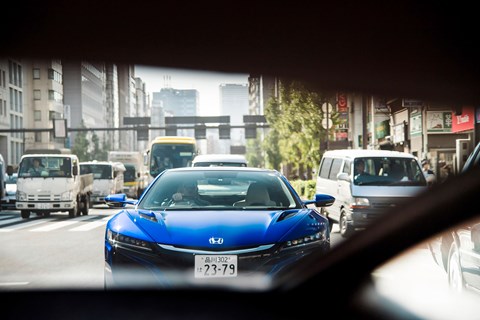
All too soon we’re back down to street level, back into the rush-hour melee and back down to business: the business of making a nuisance of ourselves in two supercars that claim to work as everyday transport, not just trackday toys – if they can cope with Tokyo, they can cope with anywhere.
The 720S is our ruling sports car of the year, a barely recognisable evolution of the 650S that came before and a startling lesson in performance with versatility. The NSX is Honda’s difficult second supercar album and a polarising car. Questions linger. Questions like why it’s a (very mild) hybrid when batteries and motors are heavy, what took it so long and why it isn’t, well, just a little more special. But the McLaren isn’t without its issues either, notably Woking’s ongoing use of its incendiary but slightly soulless turbocharged V8 when engines like Audi/Lamborghini‘s turbo-free V10 and Ferrari‘s mesmeric V12 sit on another level for emotional engagement, noise and – even with the smartest of turbines and the shortest of manifolds – throttle response.
In both cases the argument is increased real-world usability, the Honda‘s hybrid system opening up a world of all-wheel drive, torque-fill and torque vectoring possibilities while the McLaren’s turbos deliver any-rev grunt and mildly less terrifying fuel economy with their power. But while these two were created to meet similar briefs there’s conflict: more than £200,000 versus less than £145,000; structural carbon versus aluminium; turbo V8 plays hybrid V6.
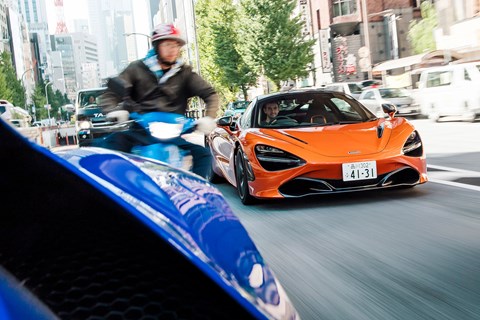
Until recently there was conflict in Formula 1, too: three unhappy seasons in which Honda very publicly failed to supply McLaren with a competitive hybrid power unit. They finally split in the autumn when it became clear the odds of repeating their past glories (most notably a run of domination in the late ’80s) had dwindled to nothing. This year McLaren will use Renault power and Honda’s hybrid V6 will sit beneath Toro Rosso engine covers.
If only McLaren could get dispensation to fit its M840T V8 into its F1 car.
Comprehensively upgraded over the 650S with a capacity hike and new plenums, pistons, cylinder heads, turbos, intercoolers, crankshaft and fuel injection system with twin injectors, the engine’s good for 710bhp, 568lb ft of torque, 0-62mph in 2.9sec and 0-124mph in 7.8sec.
Should you ever find yourself strapped into a 720S, a plumb line of dry, straight tarmac running from the car’s nose to the horizon, the few seconds of kinetic fury you can summon simply by mashing the exquisite aluminium throttle pedal are remember-for-the-rest-of-your-days stuff. In the wet, or on cold tyres in the dry (or even on warm tyres in the dry if you’re carelessly brutal) you’ll get hours of wheelspin and a bill for tyres. But match torque to grip and the thrill ride when the pair of twin-scroll turbos spin up like a dragster’s rear Hoosiers and the McLaren takes flight is flushed-cheeks, swear-out-loud furious.
The Honda’s every bit as physical over the first phase of the launch thanks to its twin-turbo V6’s three supporting electric motors (one out back and a further two driving a front wheel each). Unlike the BMW i8, the NSX isn’t a plug-in. As a result its EV range is barely beyond the end of your road, but project manager Ted Klaus maintains the hybrid system and the loftier dynamic highs the car can hit thus equipped are worth the increased complexity, cost and weight. (And the wait – NSX 2.0 took its sweet time.)
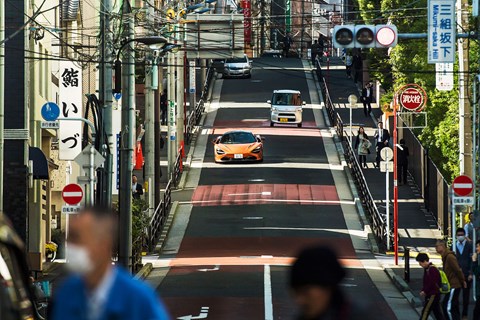
‘Packaging it all was a tremendous challenge,’ Klaus told me of the NSX’s powertrain when I first drove his baby, a truth all too evident in the car’s weight: 1847kg. Surely at night, when sleep’s eluding him and staring at the bedroom ceiling grows tedious, Klaus dreams of a hybrid-free NSX, its V6 pimped to a comparable output but with far less weight…
Running from red light to red light in a multi-lane throng the Honda feels easy, almost normal. The NSX may be mid-engined, low and lethally fast but its ergonomics, generous sight lines and jump-in-and-go ease of use make it extraordinarily, almost disappointingly accessible. It’d be wrong to say you could be in a Civic – this is most certainly a performance cockpit, from the low-slung seats to the machinations of the busy V6 behind your head – but that easy familiarity does chip away at the sense of occasion.
We flit through the sticky traffic, trying to stay in touch with scooter-mounted couriers as they bounce through the queues like free radicals. Japanese driving is almost shockingly polite and even-tempered, presenting a stark choice to tourists: go native and revel in the calm or take full advantage, hopping up the road using the kind of yawning gaps London traffic would never willingly give up.
On occasionally rough, roadwork-scarred tarmac the Honda rides pretty convincingly, its magnetic dampers soaking up shocks just as the refined cockpit keeps road noise and the engine’s exertions at arm’s length, at least until you find yourself at the front of a queue and can’t help but dole out one of the NSX’s gut-churning standing starts… The scooter rider looks back, thumb up, giant smile beneath token-gesture crash helmet. Then, as we both sense the green light coming he drops his head low, braces centrifugal clutch against brake and waits.
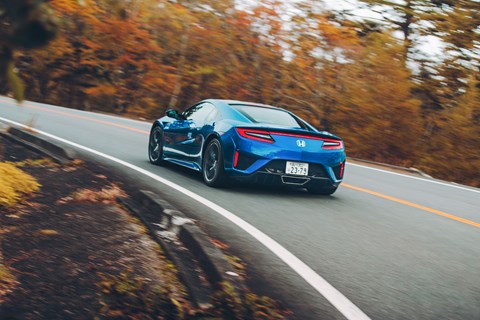
Then goes. He’s quick but the Honda’s V6 is quicker still and its motors instant, hurling us forward like a struck puck and leaving the scooter – and everything else – far behind, the NSX whipping through its bulging gearbox (just the nine ratios…) with loud clacks of its disappointingly plasticky shift paddles. They might just be the NSX’s dichotomy in microcosm: performance and capability beyond reproach saddled with inappropriately ordinary execution.
In the maze of old streets around Shinbashi station we pull over for a breather and a drink, a nearby 7-Eleven yielding a couple of cans of coffee so strong it’ll make a fine super unleaded substitute should we run low. Kei delivery vans buzz by like worker ants, scooters glide through to microscopic car parks beneath the railway arches and myriad food outlets slave to feed a population that’s only happy when it’s eating.
After the spankingly modern bay area, with its exhibition centres and international hotels, this feels like old Tokyo: a place that’s grown organically rather than been built. It’s charmingly cramped and chaotic, with a million miles of random cabling that runs over, under and across every surface like man-made vine. The McLaren may as well be invisible, so much attention does the NSX attract. The 720S is faster, newer, brighter and more expensive but the NSX is a Honda, and that name resonates here like few others. Here there are Honda shops on every street corner, de-constructed mopeds strung from their ceilings like hams, smiling technicians tending to Soichiro’s legacy like midwives to newborns. Japan loves Honda and so its people love the NSX.
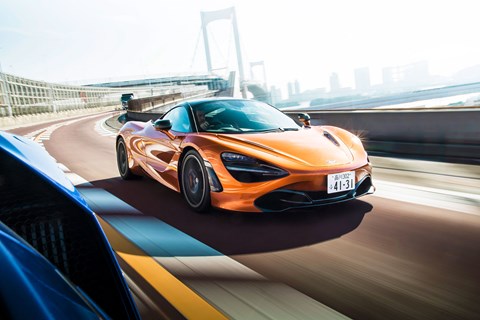
The McLaren’s interior is just as efficient as the Honda’s, just as effective, but it feels altogether more expensive (which it is) and more fittingly exotic. The NSX cockpit has a little too much Accord in it: the 720S’s is charged with performance theatre and punctuated by techy jewellery. You reach between the door skins, pull the handle to lift the door and climb into a slickly executed space of light and calm and intelligently deployed technology. The sports seats could give your lower back more support, feeling scalloped right where you want more meat, but in every other regard this is a brilliant interior. Gripes? The handbrake’s oddly placed, hidden away where you’d expect to find a headlight knob, and the one-piece shift rocker means you can’t tug both sides at once for neutral.
Slip the pocket-friendly key into the little pouch at the front of the seat (a genius touch), join the fray and the McLaren is effortless, its ergonomic rightness and placid
default manners combining to drop your heartbeat and dry your palms. The engine’s smooth from tickover, torque-rich should you need it and hooked to those vast rear tyres by a syrupy gearbox with telepathic shift mapping. In default Normal the clever suspension (decried on the 650S for being aloof, even if it did mean two wildly different chassis set-ups could live within the same four dampers) smooths broken tarmac while the 720S’s startling visibility means you’re soon confident threading gaps and getting stuck in.
And when the blue Honda alongside you nails it away from the lights you barely need break a sweat to keep up, the immense V8 summoning serious shove from as low as 3000rpm, and the rate of gain as you push the engine harder soon feeling entirely inappropriate on busy city streets. These cars may work here, calmly queuing without tantrums and taking the stress from stuttering stop/start progress with their dual-clutch gearboxes, but that doesn’t mean they don’t long for less cluttered, more challenging tarmac.
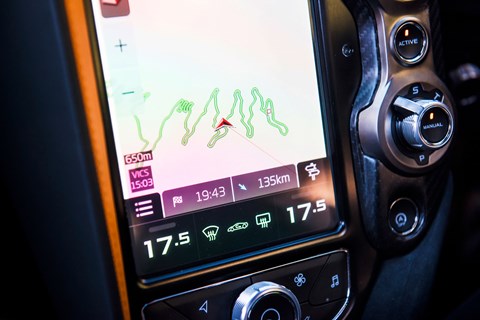
Tokyo to Mount Fuji is a pilgrimage to make for any number of reasons but today it’s for one of the two roads that run up its 12,389ft. You leave the motorway, hear the dull thump of live firing exercises on the nearby Japanese army base – even over the roar of the 720S’s 675LT-inspired exhausts – and begin to meander through a gently climbing landscape of sun-strobed woodland. That hunch you harboured that the McLaren’s steering might be a beautiful thing is proved entirely accurate within three corners, the essential rightness of the way it draws you into the car’s relationship with the road spiking your nervous system with excitement.
If a speed limit is ignored in a forest, does that speed limit exist? Set the 720S’s twin-turbo V8 free for more than a few seconds – permit yourself the indulgence of just a couple of gears, shifting at the redline – and the world freefalls away behind you, the landscape melting in the side windows before pouring off the back of the car in a blurry comet’s tail. Keep going and the final surge is truly hysterical.
Despite this wicked speed, though, it’s when the climb begins in earnest and the road bunches up like a dropped hose that the 720S takes a firm grip of your heart. With some lateral force the Normal Active Dynamics setting (new, nicely chunky controls on the panel; same slightly long-winded functionality compared to Ferrari or Porsche’s dial on the steering wheel) immediately feels too soft; lacking the resolve to let you explore the McLaren’s huge grip and potential. But ramp things up to Sport or Race and it’s like a different car, the combination of agility, grip and feedback leaving you slack-jawed, the 720S going harder, pushing further and braking deeper until you fear you’ll lose the ability to control your head long before the car runs out of talent. And when it does let go the McLaren does so gently and almost always from the rear, the engine overwhelming hot rear Pirellis just as much as your pre-selects allow, the transition from grip to slip clearly communicated by the car’s super-stiff structure.
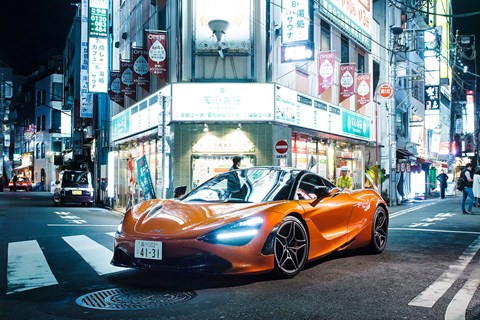
Tackling the same section in the NSX is a lesson in fractional losses. The Honda’s fast, really fast, but an order of magnitude less frenetic than the McLaren. Its brakes – which are better resolved than the 720S’s slightly numb pedal in normal driving, despite being plumbed into the powertrain’s complex regen system – can’t take the punishment this incredible stretch of road is able to provide. Similarly its conservative rubber (Continental ContiSport Contacts) bring a troubling imprecision and, ultimately, a paucity of grip. The front end pushes wide too easily and on corner-exit the rear can skip sideways fast if you’re lead-footed, the instant, hybrid-assisted shunt proving too much for tyres already busy with lateral load.
It’s dark as we steal back into the city – a city we left just three hours ago but that now feels entirely different. Tokyo is unrecognisable after dark, the absence of natural light providing a black canvas onto which the city merrily spills a Jackson Pollock of light. Tokyo’s rich automotive culture is ever-present but it too is more spectacular at night, the noise and drama of modified domestic-market weapons and revered exotics adding to the carnival atmosphere.
Dropping down from the elevated ring road feels like descending into a movie set as steam swirls from drying tarmac and lurid neon blazes across grime-streaked screens. We race along Shibuyu’s humming streets, pause at its infamous junction of a million pedestrian crossings and then turn back towards Shinbashi. Just as the endless red lights start to grate we get lucky, a string of greens giving us a clear run down the city’s broad urban canyons.
We’ve been driving for nearly 18 hours and yet still both cars are comfortable; still their driver appeal keeps us from making for home. If anything the NSX is the more capable everyday machine, its user-friendliness and less intimidating powertrain helping make urban progress as effortless as it would be in a Jazz. Shame it roasts whatever you stash in its tiny boot. Find the right road and the Honda is rapid and responsive if ultimately a little scrappy and unrewarding at the limit, like you’re doing it wrong or maybe you missed the point. Grippier tyres would help, as would an NSX Type R…
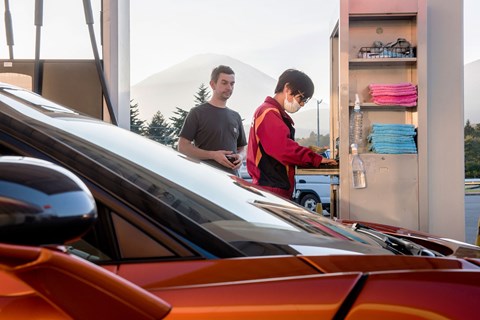
That the NSX should feel a little out-gunned here is no surprise – the 570S is the Honda’s natural Woking-built rival – but that the Honda struggles to lose a Civic Type R on serious roads is sobering. All the torque-vectoring cleverness in the world can’t overcome the handicap of all that mass.
While the non-hybrid 720S can’t claim to be a simple car it is a driving machine of uncomplicated brilliance, one whose essential excellence is a joy to experience, whether you’re mooching Shinbashi or nailing Suzuka. To drive one every day, on the kind of nothing journeys superminis were made for is overkill (threading a £200k+ car through rush hour isn’t for the nervous either) but the McLaren will do it, and do it so well it’ll make the ordinary extraordinary.
McLaren 720S specs
McLaren 720S ★★★★★
Price £208,600
Engine 3994cc 32v twin-turbo V8, 710bhp @ 7500rpm, 568lb ft @ 5500rpm
Transmission 7-speed dual clutch, rear-wheel drive
Performance 2.9sec 0-62mph, 212mph, 26.4mpg, 249g/km CO2
Suspension Double wishbone front and rear, adaptive dampers
Weight 1419kg
On sale Now
Honda NSX specs
Honda NSX ★★★★
Price £144,765
Engine 3493cc 24v twin-turbo V6 with three e-motors, 573bhp @ 6500rpm, 477lb ft @ 2000rpm
Transmission 9-speed dual clutch, all-wheel drive
Performance 2.9sec 0-62mph, 191mph, 28mpg, 228g/km C02
Suspension Double wishbone front, multi-link rear, adaptive dampers
Weight 1847kg
On sale Now
Check out more of our comparison test reviews